AORN 2000: Perioperative Nurses Spy Futuristic Surgical Suites During Exhibition
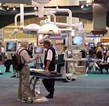
NEW ORLEANS – Barring the effects of such grievances as declining Medicare reimbursements and revenue shifts to outpatient surgery, perioperative nurses stole glimpses of what the 21st Century operating room suite should look like if hospitals have the means to pay for it.
No fewer than 10 major medical device and equipment manufacturers exhibiting at the 2000 Annual Congress of the Association of periOperative Registered Nurses showcased their visions of state-of-the-art, advanced OR and endoscopy suites enabling diagnostic imaging feeds and telemedicine capabilities. Each example was an anal-retentive person's dream on display, giving new meaning to clean and sterile and orderly.
Those perioperative nursing professionals accustomed to ORs cluttered with tables, storage cabinets, carts, video equipment, lighting fixtures, supplies and a snakepit of tangled electrical cords crawling across the floor that would make Indiana Jones sweat bullets, were pleasantly surprised at the simplicity of the latest efficiency-minded and ergonomically correct designs.
Rather than devices and equipment cluttering the OR suite floor, they were suspended from the ceiling, courtesy of two to three different ceiling-mounted columns with articulating arms. Extending from the articulating arms were surgical lights and accessory shelves that housed such equipment as camera systems, video monitors and recorders, anesthesia machines, carts, irrigation systems, gas and electric distributor outlets and surgical smoke evacuation systems. Some companies even offered battery-operated surgical tables that could be maneuvered by touch-pad or voice controls.
Perioperative nurses were also exposed to a technology that is relatively new to the surgical market – flat-panel display monitors to replace the traditional cathode ray tube (CRT) monitors. Although these monitors have permeated the radiology market during the last few years, they are now being incorporated into advanced OR suite design to emphasize their convenience and portability, particularly for storage applications.
Hill-Rom (Batesville, IN) displayed its new Prima Surgical Suite, which includes surgical lights and flat-panel monitors.
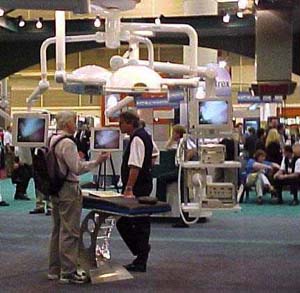
The company also helped attendees redesign their OR suites using its Suite Builder OR design program and take a three-dimensional tour of the finished product. Attendees also could take images of their OR ideas back to their respective hospitals.
Val Med Corp. (Portland, OR) extolled its experience in custom designing, equipping and installing general and minimally invasive surgery suites. Factored into its advanced OR designs include ceiling booms with single- and double-mounted flat-panel displays so that doctors can see two full images, such as laparoscopic and ultrasound views, side-by-side, according to Darko Spoljaric, Val Med's director of sales. The displays also come with handles that can be sterilized. Electrical and gas outlet access can be customized, too.
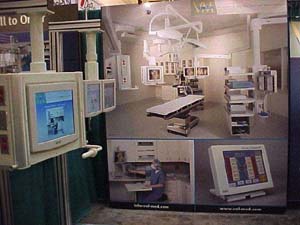
Another product Val Med highlighted was its Nurse's Assistant touch-screen control system, which allows nurses to manipulate the lighting, video and discreetly positioned overhead camera equipment in the surgical suite from one location. Spoljaric indicated that Val Med is working on voice-activated capabilities through headsets worn by surgeons and nurses. The technology will use a universal recorder rather than individual voice cards that require programming, he noted.
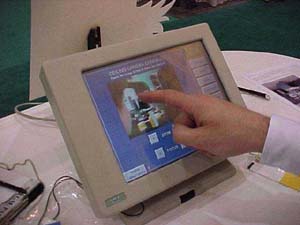
Computer Motion Inc. (Goleta, CA) showcased its "Intelligent Operating Room" that includes not only ceiling-mounted equipment booms but also computer-enhanced robotic surgical systems to assist the surgeons during complex procedures. Doctors can manipulate the company's AESOP surgical robotic arm through verbal cues.
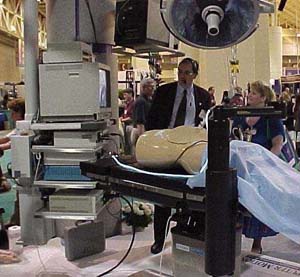
Berchtold Corp. (Charleston, SC) and Stryker Endoscopy (Kalamazoo, MI) each offered their own visions of what an efficiently organized surgical suite should look like. For example, Berchtold equipped its demonstration OR with its Chromophare surgical lights, Chromovision cameras, Teletom power booms and Televac smoke evacuation systems.
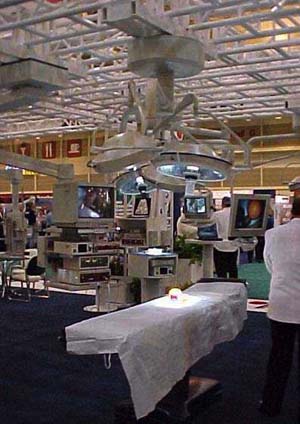
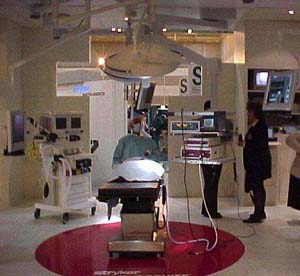
Karl Storz Endoscopy-America Inc. (Culver City, CA) promoted its OR1 surgical suite design with dual ceiling mounted booms – one housing surgical lights, cameras and flat-panel display monitors and the other holding touch-screen controls for medical devices, video and audio recording and communication equipment.
Getinge/Castle Inc. (Rochester, NY) unveiled its new FiberLux surgical lighting system, which uses fiber-optic technology to eliminate virtually all radiant heat in the surgical field that traditional lights can emit. Surgeons and nurses also can adjust the color of light emitted from the multiple-bulbed FiberLux system even as individual bulbs degrade over time, said Creighton White, Getinge/Castle's president and CEO, in a booth interview with Hospital Network.com and sister site Nurses.com. The company awaits Food and Drug Administration marketing clearance for sales in the U.S. and expects to begin shipping the product this September.
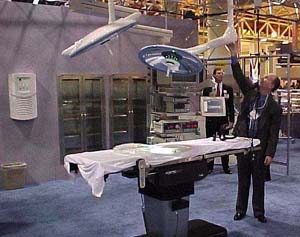
Athough FiberLux will cost a bit more than traditional lighting systems, according to White, it will be competitively priced compared to the two lighting systems healthcare facilities would have to buy in its place. Bob Von Kaenel Jr., Getinge/Castle's vice president of sales and marketing, said the company is working with Karl Storz Endoscopy to jointly market FiberLux as part of Storz's OR1 program.
Heraeus Medical Inc. (Livermore, CA) highlighted its Hanaulux surgical lighting, Hanauvision surgical video systems for telemedicine, flat-panel displays and Hanauport ceiling columns for surgery, endoscopy and anesthesiology.
At STERIS Corp. (Mentor, OH), attendees viewed two inpatient surgery suites and one outpatient surgery suites equipped with the company's own voice-activated tables, surgical lighting and video systems, ceiling-mounted equipment management systems, washing/disinfection and sterilization systems and waste management systems. STERIS also offered a computerized facilities planning service to redesign the surgical and sterile processing areas and a sterilizer chamber cleaning service.
Skytron Inc. (Grand Rapids, MI) promoted its array of surgical lights and tables (including models with 180-degree top rotation, integrated voice-control technology and orthopedic extensions), device storage and processing equipment and "space management skybooms." The ceiling-mounted equipment booms could hold detachable video carts, smoke evacuation systems and anesthesia systems.
ALM Surgical Equipment Inc. (Anaheim, CA) touted its Loadmaster single- and dual-mounted ceiling service systems with individual shelving components that can be rotated 360 degrees and adjusted for height.
